- Home
- Volume 70 (2017)
- Ecological parameters of habitat of Diptera Chironomidae in Southern Ivory Coast, West Africa
View(s): 765 (12 ULiège)
Download(s): 545 (11 ULiège)
Ecological parameters of habitat of Diptera Chironomidae in Southern Ivory Coast, West Africa

Résumé
Une étude a été menée dans 5 fermes piscicoles du sud de la Côte d’Ivoire en vue de contribuer à la connaissance des Chironomidae. L’échantillonnage a été effectué tous les mois de Décembre 2007 à Novembre 2008. Dans chaque ferme, 3 étangs ont été choisi au hasard. Dans chaque étang, 6 échantillons de sédiment ont été prélevés à l’aide d’une benne Van Veen. Les variables environnementales telles que la transparence, température, le pH, l’oxygène dissouset la conductivité ont été mesurées in situ. Les six échantillons de sédiment ont été mélangés pour constituer un seul échantillon de chaque étang. Au total 11 taxons appartenant à 3 sous-familles (Chironominae, Orthocladiinae and Tanypodinae) ont été identifiées. La faune Chironomidiènne est quantitativement et qualitativement dominée par les Chironominae. Nilodorum fractilobus, Chironomus imicola, Stictochironomus sp. et Tanypus fuscus sont les taxons les plus abondants. Les valeurs de l’indice de diversité de Shannon-Wiener et de l’équitabilité ont été enregistrées à la station d’Anyama II. Une analyse canonique a été effectuée pour montrer l’influence des paramètres environnementaux sur la distribution des taxons. Les Chironomidae peuvent être utilisés en tant que potentiel instrument d’une prochaine étude écologique dans les écosystèmes aquatiques ivoiriens.
Abstract
The aims of this study were to contribute to the knowledge of Chironomidae. Monthly samplings have been conducted from December 2007 to November 2008in five fish farms (Layo, Banco, Azaguié, Anyama I and Anyama II) in southern Ivory Coast. In each farm, sediments were collected in three ponds using a Van Veen grab. In each pond, environmental variables such as transparency, temperature, pH, dissolved oxygen and conductivity were measured in situ. Samples were taken in six replicates which were pooled to constitute a sample for each pond. A total of 11 taxa belonging to 3 subfamilies (Chironominae, Orthocladiinae and Tanypodinae) were recorded. Chironomid fauna is clearly dominated quantitatively and qualitatively by Chironominae. Nilodorum fractilobus, Chironomus imicola, Stictochironomus sp.and Tanypus fuscus were the most abundant taxa within the Chironomid assemblage. Anyama II station recorded the maximum values of Shannon-Wiener diversity index and evenness. Chironomid community structure was visualized using Canonical Correspondence Analysis to show the affinities of each specie for selected environmental parameters. Chironomidae can be used as a potential instrument in future ecology studies in Ivorian aquatic ecosystems.






